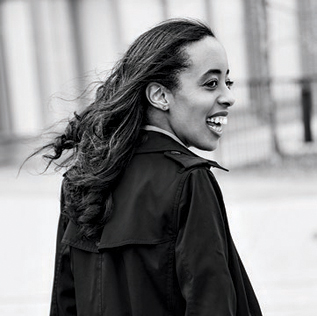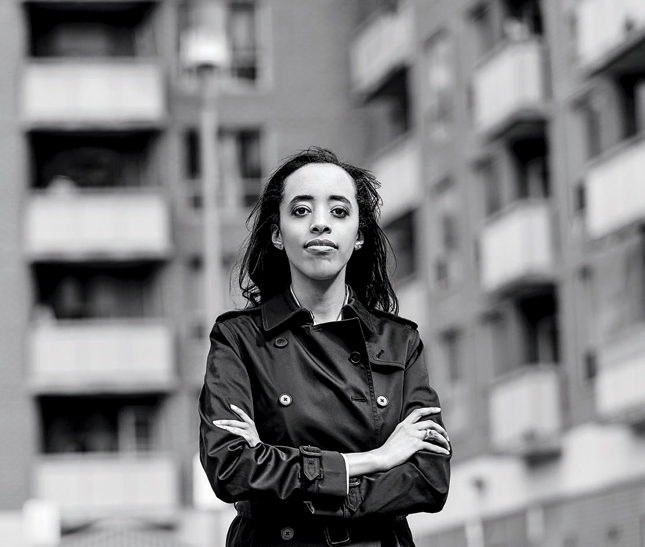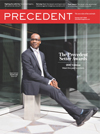Saron Gebresellassi went into personal injury law for the money. She’d articled in the area, and saw the size of the cash settlements. So after passing the bar, in 2014, she opened a solo practice. “I told myself, Keep your eyes on the prize. Get those personal injury files. Settle, settle, settle.” To land business, she hit up doctors and chiropractors, asking them to send potential clients. It worked.
But google the 30-year-old and you’ll hardly find any mention of personal injury law. Instead, you’ll see Gebresellassi using law as a tool for social justice. There she is, in the Toronto Star, suing Starbucks for $1 million on behalf of a woman who says her manager scheduled her to work with a colleague she accused of assault. And there she is, again, representing a woman who lost her job while on maternity leave.

“There’s money in personal injury, but I’m not sure I care,” says Saron Gebresellassi.
How’d she land these cases? Gebresellassi spent her student career, from undergrad through law school, as a hot-blooded, left-wing activist. Once she became a lawyer, her network sent potential civil-rights files her way. She almost always took the case. “I knew it took me away from personal injury work, but I couldn’t help myself,” she says. “Along the way, I started to think, Yes, there’s money in personal injury, but I’m not sure I care.”
Walking into Bannock, a crowded lunch joint at Queen and Bay, Gebresellassi turns to me and shouts, “This is exciting! We’re going for lunch!” She’s a fast talker with no filter. Most days, she’s at her office, meeting clients or working cases. “It can be lonely.”
Her office is five minutes from her childhood home in York Square, a low-income neighbourhood at Jane and Lawrence. “It was a political decision to start my practice there,” she says. “It’s rare that someone from a marginalized community would become a lawyer and come back.”
Gebresellassi arrived there with her parents in 1989, as refugees, when they uprooted during Eritrea’s civil war. Her father drove a Beck taxi; her mother worked at St. Michael’s Hospital. “My family emphasized education as the way out,” she says. “I was always a high performer.” Scholarships paid for her BA at Ryerson University, a master’s of education at the University of Toronto and a JD at the University of Ottawa.
But school was not her passion — at least, not once she fell in love with activism. As a student, she attended every protest she could find: anti-racism marches, pro-Palestine rallies, women’s-rights demonstrations. She even picketed with the teaching assistants at York University in 2008, a school she didn’t attend at the time, when they went on strike. “They were militant,” she recalls, beaming. “They were dedicated to fighting capitalism. I loved them.”
The reason she took on civil-rights cases, while building a personal injury practice, is that they offered her a path back into activism. Take the Starbucks lawsuit. Soon after filing it, in 2015, she staged a protest with her client to shine a light on the plight of precarious workers. “The protests at York were dynamic and exciting,” she says, waving a fork in the air. “I’d found a way, as a lawyer, to recreate that feeling.”
A year later, she took the case of Gilary Massa, a 29-year-old woman who lost her job as the executive director of communications at the Ryerson Students’ Union three months into her maternity leave. Together, they staged a women’s-rights protest. “Saron is seen as young, so people questioned my choice to hire her,” says Massa. “But, like me, she wanted to use my case to launch a conversation about human rights.”
Gebresellassi is also a de facto lawyer with Black Lives Matter Toronto. “Before protests, we often call Saron to ask her to be nearby in case anything goes wrong,” says Sandy Hudson, one of the group’s co-founders, who loves watching Gebresellassi in the press. “Saron stages rallies for her clients. When have you seen that before?”
Does this mean Gebresellassi no longer cares about money? “Oh, hell no,” she says. “I need to pay my bills.” Some clients are happy with a billable-hour model. Others agree to share a cut of a future settlement. No one gets a free ride. Many of her cases — the ones against Starbucks and Ryerson, for instance — have settled for undisclosed amounts. All she can say is that both parties came to a “successful resolution.”
In the future, Gebresellassi expects to split her time between personal injury and civil-rights cases. But the latter are riskier: if she ever loses one, her clients would be on the hook for costs. “I find that stressful.” Will that stop her from taking those cases? “No. I’m a fighter, so I don’t fold easily.”

Saron Gebresellassi
Founder, Saron Legal Professional Corporation
Year of call: 2014
Timeline of an activist lawyer
2004: At 18, Gebresellassi enrolls in the Radio and Television Arts program at Ryerson University. “I wanted to be an on-air reporter,” she says, “like Suhana Meharchand or Christiane Amanpour.”
2008: After graduation, she hightails it out of journalism — “I realized I was too political to be in media” — and earns a master’s of education at the University of Toronto.
2009: More school. Gebresellassi becomes a PhD student at York University, studying social and political thought. One year in, she quits and goes to law school at the University of Ottawa. “I wanted something more practical — and more lucrative.”
2012: As a 2L, she lands a summer job at McCarthy Tétrault LLP. “It was such a bad fit. I’m too independent to work at a big firm.” She doesn’t return to the firm for articling. “Which sounds crazy, I know. But you couldn’t pay me enough to go back. That’s not where I want to be.”
2013: Gebresellassi articles at Siganporia Law Firm, a three-lawyer personal injury firm in Toronto. This is where she learns how to run a business. “It was a really well-run operation.”
2014: Once Gebresellassi passes the bar, she launches her own litigation practice.
2017: In her first three years of practice, she takes on a string of high-profile civil-rights cases. “The feeling I get from those cases sustains me.”
 This story is from our Summer 2017 issue.
This story is from our Summer 2017 issue.
Photography by Luis Mora


